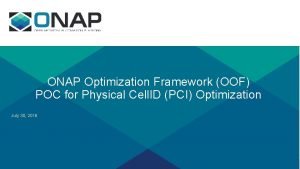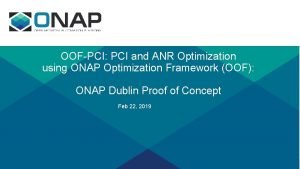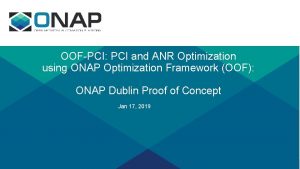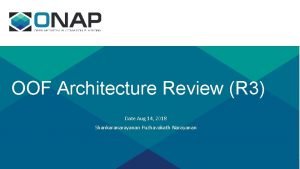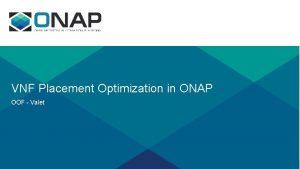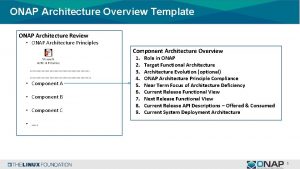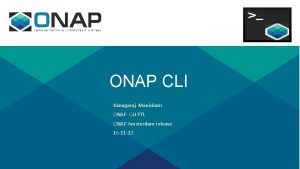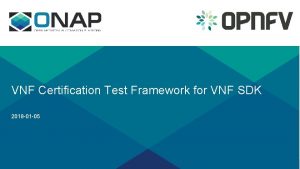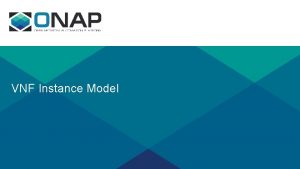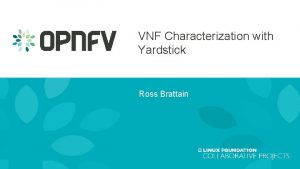VNF Placement Decision in ONAP OOF Valet What








- Slides: 8

VNF Placement Decision in ONAP OOF - Valet

What is the Placement Decision? • Homing for a given VNF instance - Select a target cloud site (or a region) - Implemented in OOF-HAS as a policy-driven homing service • Placement for virtual servers (e. g. , VMs) in each VF module of the VNF instance - Precisely check capacities of nodes & Select target nodes in the cloud site - Here, a node is either a cluster of compute hosts (e. g. , AZ) or a compute host • Certain placement decisions for tenant’s need are missed between ONAP and platform’s scheduler (e. g. , Open. Stack Nova) - e. g. , Who will decide a target AZ of a VM for Tenant, who does not know the AZ’s configuration, such as available remaining CPUs, available Host. Aggregates etc. 2

VNFs Placement Requirements Based on our experience with real VNFs, richer placement capabilities are required • Grouping rule: affinity, anti-affinity, exclusivity (i. e. , don’t share resources with others) - Each group rule is about multiple virtual servers together - Each virtual server can be involved in multiple grouping rules • Scope of grouping rule: - e. g. , datacenters, AZ, power domain (rack), host • Scope of application: - VMs within a single VF module, within a single VNF instance, or across VNFs 3

VNFs Placement Requirements Example in Open. Stack Cloud VF Module (Heat Template) Core Anti-affinity across power domains VM 1 VM 2 VM 3 To. R Placement Policies/Rules To. R VM 3 VM 1 VM 4 Valet Host 1 To. R VM 5 HA 1 Host 1 VM 5 VM 4 Exclusivity within a Host Vol VM 3 VM 5 VM 6 VM 2 VM 6 Affinity within an AZ Resource information HA 2 Vol Host 2 Rack 1 Rack 2 Rack 3 AZ 2 AZ 1

A VNF Placement Use Case A real VNF placement requirement (5 G Mobility VNF): Checking capacity and then placing VNF instances, each of which consists of 3 VMs, in a way of anti-affinity (across AZs or compute hosts) among VNF instances but affinity (within an AZ or a compute host) among 3 VMs of each VNF instance VNF-1 VM VM VM Affinity VNF-2 VM VM VM Affinity VNF-3 VM VM VM Affinity Anti-affinity 5

Why a Placement Decision in ONAP? • Consistently deal with different underlying clouds with high-level policies/requirements - private, public, or hybrid clouds - different platforms such as Open. Stack, variant of Open. Stack, Kubernetes, etc. • Smoothly combining Placement with Homing decision 6

Placement Decision Functions To connect high-level VNF placement requests into underlying cloud resources • Providing precise capacity/quota check (and reservation capability) • Meeting placement requirements/policies (Affinity, Anti-affinity, Exclusivity) - Constraints Solving • Translating universal requirement specification into native cloud specification - e. g. , Affinity and Anti-affinity -> Azure: Fault-Domain, AWS: Placement-Group - e. g. , Exclusivity -> Azure: Isolated VM, AWS: Dedicated Host 7

A Homing & Placement Flow Policy OOF/HAS+Valet For Homing & Placement decision A&AI SDNC SO Multi. Cloud Open. Stack Plug. In Azure Plug. In … Homing or Capacity check Placement of VF module 8
